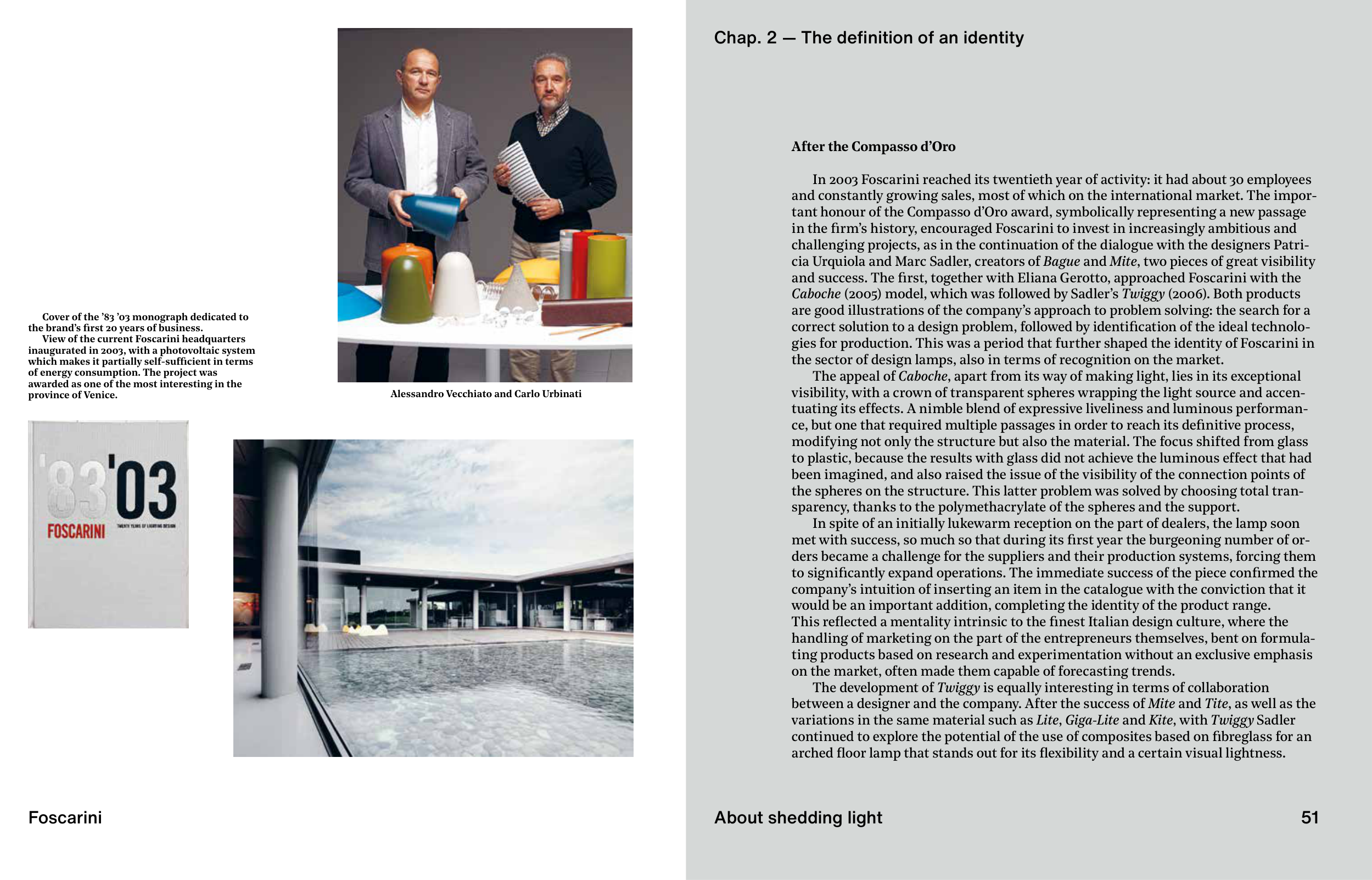Foscarini
Cap. 2 — La definizione dell’identità Foscarini
51
Alessandro Vecchiato and Carlo Urbinati
Cover of the ’83 ’03 monograph dedicated to
the brand’s fi rst 20 years of business.
View of the current Foscarini headquarters
inaugurated in 2003, with a photovoltaic system
which makes it partially self-suffi cient in terms
of energy consumption. The project was
awarded as one of the most interesting in the
province of Venice.
About shedding light
Chap. 2 — The defi nition of an identity
After the Compasso d’Oro
In 2003 Foscarini reached its twentieth year of activity: it had about 30 employees
and constantly growing sales, most of which on the international market. The impor-
tant honour of the Compasso d’Oro award, symbolically representing a new passage
in the fi rm’s history, encouraged Foscarini to invest in increasingly ambitious and
challenging projects, as in the continuation of the dialogue with the designers Patri-
cia Urquiola and Marc Sadler, creators of Bague and Mite, two pieces of great visibility
and success. The fi rst, together with Eliana Gerotto, approached Foscarini with the
Caboche (2005) model, which was followed by Sadler’s Twiggy (2006). Both products
are good illustrations of the company’s approach to problem solving: the search for a
correct solution to a design problem, followed by identifi cation of the ideal technolo-
gies for production. This was a period that further shaped the identity of Foscarini in
the sector of design lamps, also in terms of recognition on the market.
The appeal of Caboche, apart from its way of making light, lies in its exceptional
visibility, with a crown of transparent spheres wrapping the light source and accen-
tuating its effects. A nimble blend of expressive liveliness and luminous performan-
ce, but one that required multiple passages in order to reach its defi nitive process,
modifying not only the structure but also the material. The focus shifted from glass
to plastic, because the results with glass did not achieve the luminous effect that had
been imagined, and also raised the issue of the visibility of the connection points of
the spheres on the structure. This latter problem was solved by choosing total tran-
sparency, thanks to the polymethacrylate of the spheres and the support.
In spite of an initially lukewarm reception on the part of dealers, the lamp soon
met with success, so much so that during its fi rst year the burgeoning number of or-
ders became a challenge for the suppliers and their production systems, forcing them
to signifi cantly expand operations. The immediate success of the piece confi rmed the
company’s intuition of inserting an item in the catalogue with the conviction that it
would be an important addition, completing the identity of the product range.
This refl ected a mentality intrinsic to the fi nest Italian design culture, where the
handling of marketing on the part of the entrepreneurs themselves, bent on formula-
ting products based on research and experimentation without an exclusive emphasis
on the market, often made them capable of forecasting trends.
The development of Twiggy is equally interesting in terms of collaboration
between a designer and the company. After the success of Mite and Tite, as well as the
variations in the same material such as Lite, Giga-Lite and Kite, with Twiggy Sadler
continued to explore the potential of the use of composites based on fi breglass for an
arched fl oor lamp that stands out for its fl exibility and a certain visual lightness.
51


